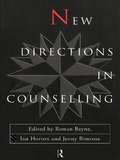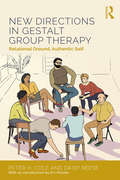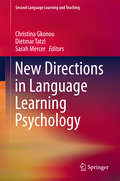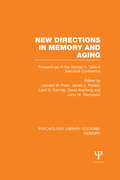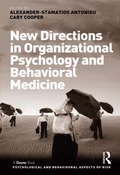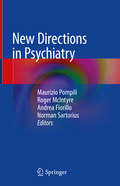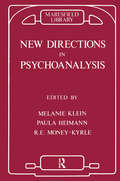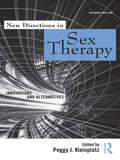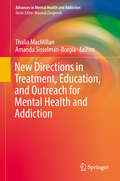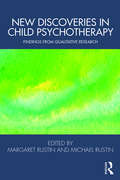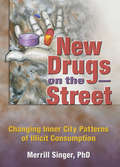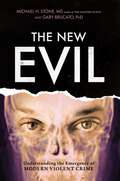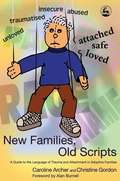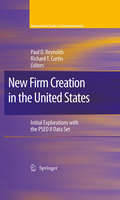- Table View
- List View
New Directions in Counselling
by Ian Horton Rowan Bayne Jenny BimroseNew Directions in Counselling responds to major changes currently affecting counselling. A team of well-known contributors identify the pressures forcing change, taking into account national and European legislation and the drive from within counselling towards greater professionalism and accountability. Part one considers the impact of accredation, National Vocational Qualifications (NVQs), developing Codes of Ethics and evaluating effectiveness. Part two looks at new interventions for common problems, such as smoking, depression, stress and abuse; new settings for counselling, including the workplace and medical practice; and new techniques, such as using narratives. The final part discusses issues in training, raising questions about the place of a feminist perspective and whether there are still myths about counselling which need to be challenged. New Directions in Counselling makes a timely response to questions affecting all counsellors, whether in training or practice.
New Directions in Gestalt Group Therapy: Relational Ground, Authentic Self
by Peter H. Cole Daisy Anne ReeseGestalt therapists often work with groups. Group therapists from a variety of theoretical orientations frequently incorporate insights and methodology from gestalt therapy. New Directions in Gestalt Group Therapy: Relational Ground, Authentic Self was written with particular attention to both gestalt and group work specialists in providing a comprehensive reference for the practice of group therapy from a gestalt perspective. In includes an introduction to gestalt therapy terms and concepts written to make the gestalt approach understandable and accessible for mental health practitioners of all backgrounds. It is appropriate for students as well as seasoned psychotherapists. Peter Cole and Daisy Reese are the co-directors of the Sierra Institute for Contemporary Gestalt Therapy located in Berkeley, California. They are the co-authors of Mastering the Financial Dimension of Your Psychotherapy Practice and True Self, True Wealth: A Pathway to Prosperity. They are a married couple, with five children and four grandchildren between them.
New Directions in Human Associative Learning
by Andy J. WillsThe editor and authors of this book present a synthesis of work on human associative learning, tracing some of its historical roots but concentrating mainly on recent developments. It is divided into three sections: an introduction to the recent data and controversies in the study of human associative learning; recent developments in the formal theories of how associative learning occurs; and applied work on human associative learning, particularly its application to depression and to the development of preferences. The book is designed to be accessible to undergraduates, providing a clear illustration of how principles most commonly introduced in animal cognition courses are relevant to the contemporary study of human cognition.
New Directions in Language Learning Psychology
by Sarah Mercer Christina Gkonou Dietmar TatzlThis book explores potential new directions in the growing field of language learning psychology. The individual chapters cover theoretical and conceptual developments and innovative methodological designs, while also exploring practical implications. Language learning psychology is a vibrant field of research that typically involves constructs from social and educational psychology, which it considers in terms of their relevance for the domain of language learning. The diverse theoretical and empirical chapters examine a range of familiar and lesser-known constructs, highlighting the importance of taking into account both learner and teacher psychologies, and recognising the complexity, dynamism and situatedness of psychological constructs, as well as the value of employing diverse research methodologies. It is hoped that these 'new directions' concerning populations, constructs and theoretical and methodological frameworks will pave the way for innovative future developments in this vibrant field.
New Directions in Memory and Aging: Proceedings of the George A. Talland Memorial Conference (Psychology Library Editions: Memory)
by Leonard W. Poon James L. Fozard Laird S. Cermak David Arenberg Larry W. ThompsonOriginally published in 1980, this book contains the proceedings from a memorial conference held in honour of George A. Talland, who made a significant contribution to the area of memory and aging. The major objective of the volume was to stimulate research towards a more comprehensive understanding of age related differences in memory. It was also hoped it would provide direction for the application and utilization of research findings in the evaluation and treatment of memory complaints and memory difficulties experienced by the elderly. The book was intended for two broad groups of scientists. The first being researchers in the psychology of memory, and those who were currently active in the research on aging at the time. The second group was those concerned with applying current research findings to the diagnosis and treatment of problems of memory.
New Directions in Organizational Psychology and Behavioral Medicine (Psychological and Behavioural Aspects of Risk)
by Cary CooperThis research shows the dynamic relationship between work, health and satisfaction. New Directions in Organizational Psychology and Behavioral Medicine, comprehensively covers new developments in the field of occupational health psychology and provides insight into the many challenges that will change the nature of occupational health psychology. The editors have gathered 40 experts from all over the developed world to discuss issues relevant to human resource and talent management, and specifically to employment related physical and psychological health issues. Especially because it comes at a time of economic turbulence that will create work stress and strain, organizations, researchers and practitioners will find this book valuable.
New Directions in Psychiatry
by Norman Sartorius Andrea Fiorillo Maurizio Pompili Roger McIntyreThis book focuses on hot issues faced by clinicians in everyday clinical practice, and provides in-depth analyses of both met and unmet needs in the management of psychiatric disorders. It has been repeatedly shown that the needs of patients, relatives, the community at large and those of the governmental bodies only partially overlap. For instance, patients in their families are more concerned about quality of life, treatment, autonomy, and independent living; whereas governmental stakeholders are typically more concerned about relapse prevention and reduction of hospitalizations. As such, a volume bridging the gap between theoretical notions and practical understanding of patients’ untreated aspects of their psychiatric disorders is much needed. Instead of focusing on traditional descriptions of psychopathology and diagnostic criteria, the volume guides readers to core problems for each topic, taking into account new approaches in the classification of mental disorders as proposed by DSM-5. It elaborates on much-debated controversial problems such as the assessment and treatment of psychomotor agitation, and non-adherence to treatment that impacts on the psychiatric context. With its unique approach, this volume appeals to anyone with an interest in the field, including researchers, clinicians, and trainees.
New Directions in Psychoanalysis: The Significance of Infant Conflict in the Pattern of Adult Behaviour
by Dominique SchnapperThis book contains papers varying from the subject of psychoanalytic theory and therapy to the psychoses and applied psycho-analysis. It emphasizes the infant's constant struggle with his internal-object-relations, internal war of mental objects, and his drive towards 'reparation'.
New Directions in Rational Emotive Behaviour Therapy
by Windy DrydenNew Directions in Rational Emotive Behaviour Therapy brings together leading figures from the world of Rational Emotive Behaviour Therapy (REBT), both as a testament to the work of Albert Ellis and as a reminder of the vibrancy and vigour of the approach. The chapters in this book, taken together, show that REB therapists are open to broader developments in the fields of counselling and psychotherapy in general and can also contribute to these developments. The book introduces REBT to readers who are more familiar with CBT and locates REBT within the broader fields of CBT and modern psychotherapy. The book will interest REBT and CBT therapists and more broadly it will interest those in the helping professions wishing to explore what REBT can currently offer them and how this approach can be practiced.
New Directions in Sex Therapy: Innovations and Alternatives
by Peggy J. KleinplatzWinner of the 2013 AASECT Professional Book Award! New Directions in Sex Therapy: Innovations and Alternatives focuses on cutting-edge, therapy paradigms as alternatives to conventional clinical strategies. With each passing year, the treatment of sexual problems seems to emphasize more medical and pharmacological interventions. There is correspondingly less interest in the experiences of the individuals or couples involved. This book expands the definition of our field. Part I highlights the major problems and criticisms facing sex therapy and furnishes a rationale for new directions. Included in this new edition are critiques of "sexual addiction" nomenclature, the neglect of the ethical dimension in sex therapy, and there is a call to expand our vision of what sex therapy can attain. Part II demonstrates new approaches to dealing with traditional sex therapy concerns, including lack of desire and erectile dysfunction as well as innovative goals, such as integrating sexual medicine with sex therapy, using client feedback to customize therapy for the particular individual/couple's best interests, promoting relationship growth in working with transgender clients, and transcending sexual function/dysfunction to optimize erotic intimacy in long-term couples. This 2nd edition of New Directions in Sex Therapy: Innovations and Alternatives is replete with helpful new clinical illustrations across the spectrum of theoretical orientations (e.g., systemic, narrative, Experiential, CBT) to demonstrate these approaches in action. This book is intended for anyone who deals with sexual issues and concerns in therapy–clinicians of every kind, novices and advanced practitioners–rather than only those who define themselves as sex therapists.
New Directions in Sex Therapy: Innovations and Alternatives
by Peggy J. KleinplatzNew Directions in Sex Therapy: Innovations and Alternatives, Third Edition focuses on new and cutting-edge therapy paradigms as alternatives to conventional clinical strategies, challenging practitioners to expand our thinking about how to deal with sexual concerns. In the third edition of this award-winning book, Peggy J. Kleinplatz, Ph.D., brings together the best therapists and sexologists to advance beyond predominant approaches to sexual difficulties.Part I highlights the major problems and criticisms facing sex therapy and furnishes a rationale for new directions, with chapters on ethics, heteronormativity and comprehensive sexual education/healthcare as human rights issues. Part II demonstrates new approaches to dealing with traditional sex therapy concerns, including sexual desire discrepancies, difficulties with erections and orgasms and sexuality in older couples. There is also attention to concerns typically overlooked including those related to consensual nonmonogamy, sexuality and disability and marginalized populations. This edition is replete with helpful new clinical illustrations across the spectrum of theoretical orientations, such as EFT/EFIT, narrative-relational, psychodynamic, CBT, experiential and group therapy modalities to demonstrate these approaches in action. There are also queer-informed perspectives on sex and relationships and innovative contributions on the person of the therapist and on promoting optimal erotic intimacy.This book is intended for students and clinicians who deal with sexual issues and concerns in therapy – clinicians of every kind, novices and advanced practitioners – rather than only those who define themselves as sex therapists.
New Directions in Treatment, Education, and Outreach for Mental Health and Addiction (Advances in Mental Health and Addiction)
by Thalia MacMillan Amanda Sisselman-BorgiaThis practice-enhancing volume assembles the latest innovative thinking on working with clients who have both mental health diagnoses and substance use disorders. Diagnosis is a central focus of the coverage, untangling the often-knotty considerations surrounding dual diagnosis and the complex issues surrounding treatment even in frequently seen combinations (e.g., depression/alcohol abuse). The section on practice emphasizes meeting patients where they are and making use of their community, cultural, and spiritual contexts in crafting interventions. And the book’s ambitious chapters on professional development describe training programs with the potential to produce the next generation of responsive, knowledgeable, and flexible therapists.Among the topics covered:· Comprehensive assessment of substance abuse and addiction risk in adolescents.· The relationship between attachment and addiction.· Addiction in the community: the role of emergency services.· Substance use during and after major crisis and disaster: a practitioner’s guide.· Practice, advocacy, and outreach: perspectives on addiction services.· Teaching the importance of developing the therapeutic relationship.New Directions in Treatment, Education, and Outreach for Mental Health and Addiction equips health and clinical psychologists, social workers, and addiction counselors and educators with a well-rounded understanding of a growing population, and a wealth of perspectives on effective new interventions.
New Directions in the Ethics of Assisted Suicide and Euthanasia
by Michael Cholbi Jukka VareliusThis book provides novel perspectives on the ethical justifiability of assisted dying. Seeking to go beyond traditional debates on topics such as the value of human life and questions surrounding intention and causation, this volume promises to shift the terrain of the ethical debates about assisted dying. It reconsiders the role of patient autonomy and paternalistic reasons as well as the part proposed for medical professionals and clinical ethics consultation in connection with assisted dying, relates the debate on assisted dying to questions about organ-donation and developments in medical technology, and demonstrates the significance of experimental philosophy in assessing questions of assisted dying. This book is ideal for advanced courses in bioethics and health care ethics.
New Directions in the Psychology of Close Relationships
by Dominik Schoebi Belinda CamposWhat makes for strong and enduring relationships? It is a question of increasing scientific and popular interest as it has become clear that relationships can make life happier, healthier, and longer. In this collection, the reader will find an overview of state-of-the-art research on this question and a glimpse of the new directions that will define the future of this field of study. With contributions from leading scholars in the field, the book offers cutting-edge perspectives on the factors and processes that contribute to strong, thriving, and resilient close relationships. Split into three parts, the first part discusses important factors and processes contributing to strong relational bonds in the form of different types of relationships. The second part spotlights contexts such as culture and gender as the domain for future advances in this area of research. Finally, the last part covers data analytic techniques and future directions. Offering a unique perspective on each topic covered, the authors highlight the promising next steps which will inspire advances in the field in the years to come. Bringing together important trends from different areas of research, this text will make a significant contribution to social psychology and is essential for students and academics interested in the psychology of relationships.
New Discoveries in Child Psychotherapy: Findings from Qualitative Research (Tavistock Clinic Series)
by Michael Rustin Margaret RustinNew Discoveries in Child Psychotherapy presents eleven new contributions to child psychoanalytic research, most of them based on the experience of the clinical consulting room. Each chapter is the work of an experienced child psychotherapist or child analyst, vivid in their description of the children and families they encountered. Their understanding of the "inner worlds" of patients and the clinical consulting room is clearly evidenced in their analysis of clinical presentations. The chapters are the result of the psychoanalytic clinical and observational practices of their authors, allied to their use of rigorous qualitative research methods, in particular Grounded Theory and interpretative phenomenological analysis (IPA). They describe developments of child psychoanalytic knowledge in several fields, including autism, psychotherapy with severely deprived children, and the study of early infancy. They demonstrate advances in child psychoanalytic theories and methods and the development of new forms of clinical service provision. Contested issues in psychoanalytic research are thoroughly evaluated, showing how it can be made more accountable and rigorous through the adaptation of established qualitative research methods to the study of unconscious mental phenomena. New Discoveries in Child Psychotherapy will be an essential text in the field of child psychoanalysis and will be highly useful in psychotherapy and psychoanalysis training courses and for psychoanalytic researchers, as well as for practitioners.
New Discoveries in the Behavioral Neuroscience of Attention-Deficit Hyperactivity Disorder (Current Topics in Behavioral Neurosciences #57)
by Emma Sciberras S Clare StanfordNew Discoveries in the Behavioral Neuroscience of Attention Deficit Hyperactivity Disorder reviews the latest developments in preclinical and clinical research of Attention Deficit Hyperactivity Disorder. As well as updating key chapters that were included in an earlier edition, this volume includes some new topics that are attracting a great deal of interest and point the way to new and promising directions for future research. The chapters follow five main themes: Current perspectives on the clinical profile of ADHD and its treatment, common co-occurring conditions, neurobiological studies examining brain function and genetics, animal and in vitro studies, and future directions. This combination of topics emphasises the translational relevance and validity of preclinical research so as to enable a better understanding of ADHD and to highlight the promising strategies for developing new treatments.
New Drugs on the Street: Changing Inner City Patterns of Illicit Consumption
by Merrill SingerLearn the public health implications of shifting drug-related risks among the inner city poorInner city drug use behavior shifts and changes, leaving past drug treatment programs, drug prevention efforts, health care provisions for drug users, and social service practice unprepared to effectively respond. New Drugs on the Street: Changing Inner City Patterns of Illicit Consumption tackles this problem by presenting the latest ethnographic and epidemiological studies of emerging and changing drug use behaviors in the inner city. This one-of-a-kind resource provides the latest research to help readers reconceptualize ways to think about today&’s drug use to more effectively address the growing problem.Unless public health and social service professionals keep in step with the shifting patterns of drug behaviors, drug use epidemics will inevitably unfold. New Drugs on the Street reveals the latest drug use practices of the poor in the inner city, with a concentration on the research in African-American and Latino populations. Each chapter gives an in-depth look at the use of various psychotropic drugs most recently gaining popularity, along with the surprising reemergence of PCP. The rampant use of ecstasy in the rave scene is explored, along with the effects of its heavy use, its after-effects, the likelihood of poly-drug mixing, and dangerous sex risk behaviors. Urban youth drug networking is examined in detail. The alarming use of embalming fluid mixtures is discussed, along with the disturbing public health implications of its use. The illicit use of narcotics analgesics (NA) like Vicodin and other pain killers is also explored, including the unclear association between NA use and Hepatitis C. A final chapter presents the latest information on Haitian youth and young adults in Miami, Florida, with ethnographic background to illustrate the reasons for drug use in this and other ethnic minorities. This valuable source is extensively referenced and includes several helpful tables to clarify research data.New Drugs on the Street examines: ecstasy diverted pharmaceutical painkillers PCP embalming fluid narcotics analgesics (NA) drug use dynamics the changing street drug scene new drug combinations new drug-involved populationsNew Drugs on the Street reveals the nature and direction of the latest drug use and is essential reading for health professionals in the health social sciences, public health, nursing, and substance abuse fields that deal with low income, ethnic minority, and inner city populations.
New Dynamics in Old Age: Individual, Environmental and Societal Perspectives
by Jon Hendricks Hans-Werner Wahl Clemens Tesch-Romer Dr. Andreas HoffThis book was nurtured by the belief that the new dynamics of today's and tomorrow's aging has not yet been treated well in the gerontology literature. Several questions drove the choice of substance for the book: What kind of new dynamics of aging deserves consideration? What kinds of theories and fields are at the core of treating such a new dynamics? And what kind of empirical evidence should be considered? The master hypothesis on which the book is based maintains that the new dynamics of old age is best observed in a range of everyday aging contexts that have been undergoing major change since the second half of the 20th century. In particular, five areas of new and persistent dynamics are treated in depth: the social environment, with a focus on cohort effects in social relations and the consideration of family relations and elders as care redelivers; the home environment, with emphasis on housing and quality of life, relocation and urban aging issues; the outdoor environment, with consideration of out-of-home activity patterns, car-driving behaviour and the leisure world of aging; the technological environment, with treatments of the role of the Internet and the potential of technology for aging outcomes and; and the societal environment with a focus on global aging, the new politics of old age and older persons as market consumers. The book's main purpose is to provide the scholarly gerontology community with a comprehensive and critical discussion of these new trends related to old age. The book will be of interest for the scholarly community of gerontology in a variety of disciplines; sociology, psychology, demography, epidemiology, humanities, social policy and geriatrics; students in gerontology education and in the disciplines named above who have an interest in aging issues (graduate level); professionals in practical and applied fields related to aging such as community and urban planners, health and care providers and policymakers; people involved in senior citizens' organizations and those in industry who wish to serve older people with new products.
New Essays in Technical and Scientific Communication: Research, Theory, Practice
by Paul V Anderson John R Brockman Carolyn R MillerNew Essays in Technical and Scientific Communication represents the most important collection of writings about technical communications ever compiled. Focusing on a wide range of theoretical and practical issues, these essays reflect the rigor, vitality, and interdisciplinary nature of modern technical communications. This represents a collection of the very best scholarly work being done.
New Essays on the Psychology of Art
by Rudolf ArnheimThousands of readers who have profited from engagement with the lively mind of Rudolf Arnheim over the decades will receive news of this new collection of essays expectantly. In the essays collected here, as in his earlier work on a large variety of art forms, Arnheim explores concrete poetry and the metaphors of Dante, photography and the meaning of music. There are essays on color composition, forgeries, and the problems of perspective, on art in education and therapy, on the style of artists' late works, and the reading of maps.Also, in a triplet of essays on pioneers in the psychology of art (Max Wertheimer, Gustav Theodor Fechner, and Wilhelm Worringer) Arnheim goes back to the roots of modern thinking about the mechanisms of artistic perception.
New Evil: Understanding the Emergence of Modern Violent Crime
by Michael E. Stone Gary Brucato PhDRevisiting Dr. Michael Stone's groundbreaking 22-level Gradations of Evil Scale, a hierarchy of evil behavior first introduced in the book The Anatomy of Evil, Stone and Dr. Gary Brucato, a fellow violence and serious psychopathology expert, here provide even more detail, using dozens of cases to exemplify the categories along the continuum. The New Evil also presents compelling evidence that, since a cultural tipping-point in the 1960s, certain types of violent crime have emerged that in earlier decades never or very rarely occurred. The authors examine the biological and psychiatric factors behind serial killing, serial rape, torture, mass and spree murders, and other severe forms of violence. They persuasively argue that, in at least some cases, a collapse of moral faculties contributes to the commission of such heinous crimes, such that "evil" should be considered not only a valid area of inquiry, but, in our current cultural climate, an imperative one. They consider the effects of new technologies and sociological, cultural, and historical factors since the 1960s that may have set the stage for "the new evil." Further, they explain how personality, psychosis, and other qualities can meaningfully contribute to particular crimes, making for many different motives.Relying on their extensive clinical experience, and examination of writings and artwork by infamous serial killers, these experts offer many insights into the logic that drives horrible criminal behavior, and they discuss the hope that in the future such violence may be prevented.
New Families, Old Scripts: A Guide to the Language of Trauma and Attachment in Adoptive Families
by Caroline ArcherMost adopted children and their families will, sooner or later, encounter the challenges of dealing with unresolved attachment issues or early traumatic experiences. New Families, Old Scripts is an accessible introduction to understanding these challenges and helping children and their families to develop a shared language and understanding of one another. Steeped in the experience of the authors, the book offers a wealth of practical guidance and intervention in a no-nonsense style that will be readily understandable to both families and the professionals who work with them. Case examples bring the issues to life, while sample letters addressed to the parent offer sensitive, jargon-free advice on the issues they are likely to encounter - whether it be dealing with anger and aggression, understanding sibling issues or how to react to sexualised behaviour. The authors also explain some of the theoretical background to trauma to encourage a better understanding of the relationship between trauma, attachment and development. The accessible combination of theoretical approaches and practical advice makes New Families, Old Scripts an ideal resource for social workers and adoptive or foster parents. Family Futures Consortium provides services for parents and professionals working with adopted and fostered children, including training and consultation for statutory and voluntary agencies nationwide. In their therapeutic work with families, they have evolved a unique intensive, multi-disciplinary approach to supporting children with attachment and trauma-related difficulties.
New Feminist Stories of Child Sexual Abuse: Sexual Scripts and Dangerous Dialogue
by Sam Warner Paula ReaveyThe international feminist contributors to this book look through the lens of poststructuralism at how child sexual abuse is differently represented and understood in the populist, academic, clinical, media and legal contexts. Reworking earlier feminist analyses, they show how child sexual abuse is not just about gender and power but also about class, race and sexuality. The first, theoretical section of the book critiques normative theories of the 'effects' of abuse, explores the impact and consequences of feminist interventions and critically examines the potential usefulness of a feminist post-stucturalist approach. In the second part, these understandings are applied to specific arenas of practice with the aim of providing a framework for critical intervention and alternative and better ways of working with child sexual abuse.
New Firm Creation in the United States
by Richard T. Curtin Paul D. ReynoldsThis volume includes contributions from the organizers and advisory board members of the Panel Study of Entrepreneurial Dynamics (PSED) II project, designed to enhance the scientific understanding of how people start businesses. Covering such topics as entrepreneurial behavior, demographic and gender factors, financing the emerging business, ownership arrangements, and the roles of social capital and technology, the information obtained includes data on the nature of those active as nascent entrepreneurs, the activities undertaken during the start-up process, and the characteristics of start-up efforts that become new firms. Including an appendix explaining the data collection procedures, the result is an introduction to the theories, conceptualizations, approaches, and measurement of the business creation process, and a guide for those planning more detailed analysis.
New Forms and Expressions of Conflict at Work
by Gregor GallA survey and analysis of the new forms and expressions of conflict at work under capitalism. This collection uses theoretical and empirical approaches to demonstrate that there is an underlying historical continuity to current and new forms and expressions of conflict at work and that there is also a path dependency by country and culture. Although the strike is in decline in many countries, it is not so in all and different means of expressing and resolving collective grievances are used but not always as substitutes to the weapon of strike.
